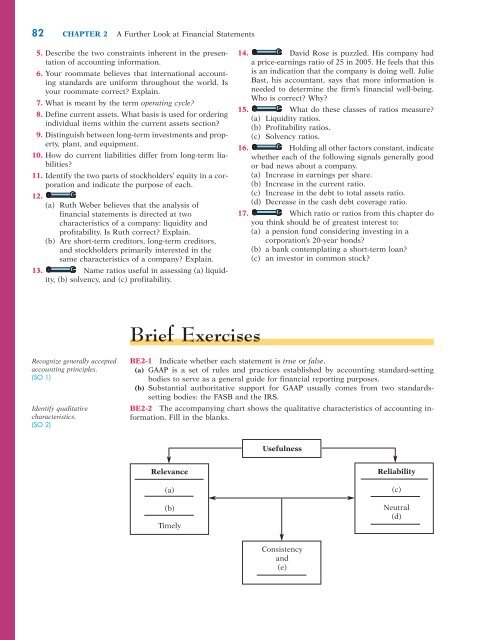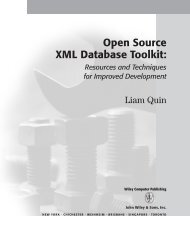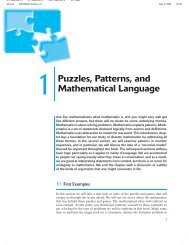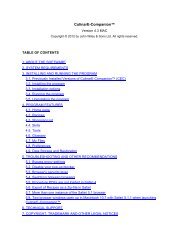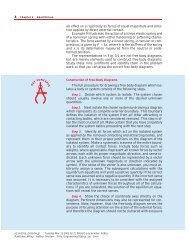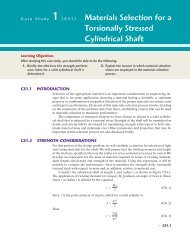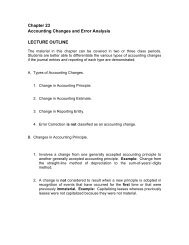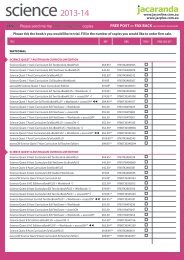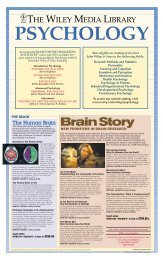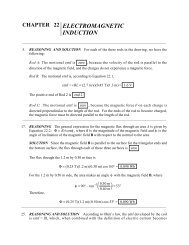Chapter Two - Wiley
Chapter Two - Wiley
Chapter Two - Wiley
Create successful ePaper yourself
Turn your PDF publications into a flip-book with our unique Google optimized e-Paper software.
8956d_ch02_082 8/20/03 12:56 PM Page 82 mac76 mac76:385_reb:<br />
82 CHAPTER 2 A Further Look at Financial Statements<br />
5. Describe the two constraints inherent in the presentation<br />
of accounting information.<br />
6. Your roommate believes that international accounting<br />
standards are uniform throughout the world. Is<br />
your roommate correct? Explain.<br />
7. What is meant by the term operating cycle?<br />
8. Define current assets. What basis is used for ordering<br />
individual items within the current assets section?<br />
9. Distinguish between long-term investments and property,<br />
plant, and equipment.<br />
10. How do current liabilities differ from long-term liabilities?<br />
11. Identify the two parts of stockholders’ equity in a corporation<br />
and indicate the purpose of each.<br />
12.<br />
(a) Ruth Weber believes that the analysis of<br />
financial statements is directed at two<br />
characteristics of a company: liquidity and<br />
profitability. Is Ruth correct? Explain.<br />
(b) Are short-term creditors, long-term creditors,<br />
and stockholders primarily interested in the<br />
same characteristics of a company? Explain.<br />
13. Name ratios useful in assessing (a) liquidity,<br />
(b) solvency, and (c) profitability.<br />
14. David Rose is puzzled. His company had<br />
a price-earnings ratio of 25 in 2005. He feels that this<br />
is an indication that the company is doing well. Julie<br />
Bast, his accountant, says that more information is<br />
needed to determine the firm’s financial well-being.<br />
Who is correct? Why?<br />
15. What do these classes of ratios measure?<br />
(a) Liquidity ratios.<br />
(b) Profitability ratios.<br />
(c) Solvency ratios.<br />
16. Holding all other factors constant, indicate<br />
whether each of the following signals generally good<br />
or bad news about a company.<br />
(a) Increase in earnings per share.<br />
(b) Increase in the current ratio.<br />
(c) Increase in the debt to total assets ratio.<br />
(d) Decrease in the cash debt coverage ratio.<br />
17. Which ratio or ratios from this chapter do<br />
you think should be of greatest interest to:<br />
(a) a pension fund considering investing in a<br />
corporation’s 20-year bonds?<br />
(b) a bank contemplating a short-term loan?<br />
(c) an investor in common stock?<br />
Brief Exercises<br />
Recognize generally accepted<br />
accounting principles.<br />
(SO 1)<br />
Identify qualitative<br />
characteristics.<br />
(SO 2)<br />
BE2-1 Indicate whether each statement is true or false.<br />
(a) GAAP is a set of rules and practices established by accounting standard-setting<br />
bodies to serve as a general guide for financial reporting purposes.<br />
(b) Substantial authoritative support for GAAP usually comes from two standardssetting<br />
bodies: the FASB and the IRS.<br />
BE2-2 The accompanying chart shows the qualitative characteristics of accounting information.<br />
Fill in the blanks.<br />
Usefulness<br />
Relevance<br />
(a)<br />
(b)<br />
Timely<br />
Reliability<br />
(c)<br />
Neutral<br />
(d)<br />
Consistency<br />
and<br />
(e)


